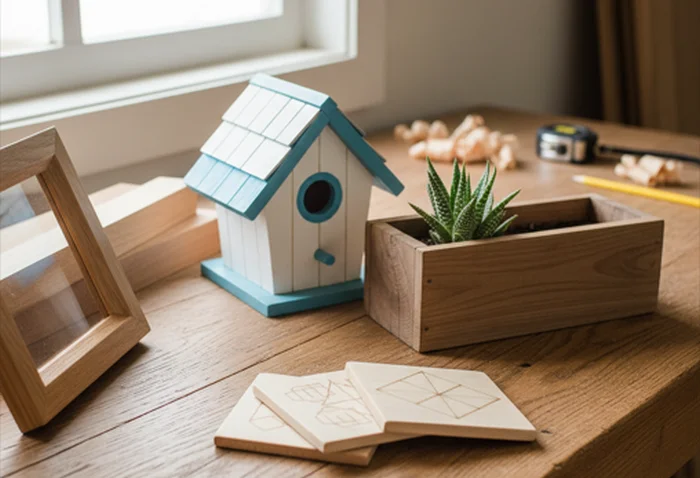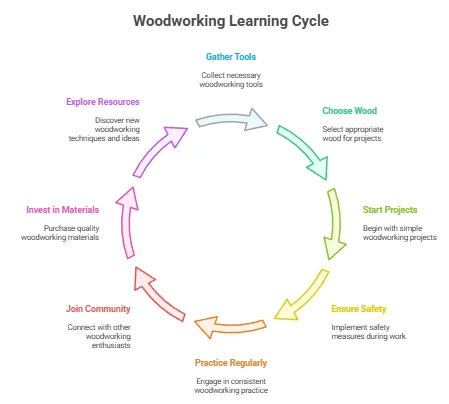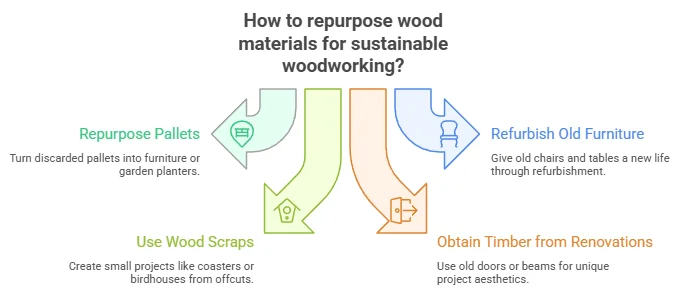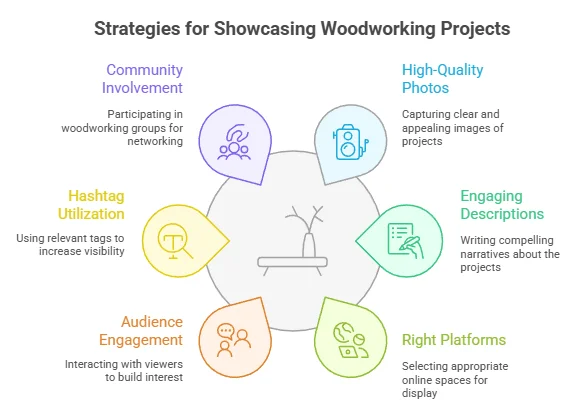
Woodworking is not just an art but also a fantastic way to express creativity, especially when you’re looking for free small woodworking projects . Whether you’re a beginner or an experienced craftsman, there are plenty of simple projects that can produce beautiful results without breaking the bank. These projects require minimal materials and tools and can often be completed in a weekend. Here are some innovative ideas to get you started.
Simple Projects to Get Your Creativity Flowing
-
Birdhouses
Creating a birdhouse is an enjoyable project that not only beautifies your backyard but also supports local wildlife. You can use leftover wood scraps or reclaimed materials to minimize costs. A basic birdhouse design includes a front wall with an entrance hole, a back wall, a floor, and a roof. You can paint or decorate them to add your style.
-
Wooden Planters
Wooden planters are versatile and fun to make. You can construct them in various shapes and sizes to fit your plants. Start with a simple rectangular box design. Cut the wood pieces to size and assemble them using nails or screws. Remember to drill drainage holes! You can find tutorials online, like on Wood Magazine.
-
Coasters
Making coasters is a simple yet effective project. Use wood slices or cut pieces of plywood into squares or circles. Sand them down for a smooth finish and seal them with a wood finish to protect against moisture. You can get creative by adding engravings or painting designs on them.
-
Picture Frames
Handmade picture frames can add a personal touch to your home décor. Gather some wood scraps and cut them into pieces to create a rectangular frame. Assemble the corners using wood glue and clamps, and once dry, paint or stain the frame to your liking. This project is not only easy but also allows you to showcase your favorite memories. Visit Instructables for detailed ideas.
-
Key Holders
A key holder is a practical project that helps keep your keys organized. You can make a simple wooden board with hooks attached for hanging keys. Customize it by painting the wood in vibrant colors or adding a family name. Not only is this functional, but it also adds a nice touch to your entryway.
Using Your Space Wisely
Be sure to consider your workspace when undertaking these projects. Here are some tips for creating an effective woodworking environment:
- Safety First: Always wear protective gear like gloves and goggles.
- Keep It Clean: A tidy workspace can help prevent accidents.
- Organize Tools: Arrange your tools for easy access. Use pegboards or containers for a better layout.
Resources for Inspiration
Seeking inspiration is essential when embarking on woodworking projects. Online resources provide endless ideas and guidance. Some recommended websites include:
- Ana White – Features beginner-friendly plans.
- Woodworkers Source – Offers a community-driven platform with project ideas.
- The Wood Whisperer – Great for video tutorials and advanced projects.
Essential Tools You Need for Woodworking at Home
Woodworking at home can be a fulfilling hobby, offering a creative outlet and practical solutions. Whether you’re a beginner or looking to refine your skills, having the right tools is crucial. Here’s a guide to essential tools that will set you up for success in your home woodworking projects.
Basic Hand Tools
Start with a solid foundation of hand tools. These tools are manageable and often require no electricity:
- Hand Saw: Great for making precise cuts. Look for both crosscut and rip saws for different tasks.
- Chisels: A set of chisels in varying sizes will be important. They are used for carving and detailed work.
- Claw Hammer: Ideal for driving and pulling nails. A good hammer should fit comfortably in your hand.
- Square: A framing square or combination square ensures your cuts are accurate, keeping your projects true.
- Measuring Tape: A sturdy measuring tape is vital for ensuring your dimensions are precise.
Power Tools for Efficiency
As you progress, integrating power tools can enhance your efficiency and expand your project options. Here’s what you should consider adding to your toolkit:
- Circular Saw: Perfect for making quick cuts. It’s versatile for both crosscuts and rip cuts.
- Jigsaw: This tool allows you to cut curves and intricate designs into wood.
- Power Sander: An electric sander can significantly reduce the time it takes to smooth surfaces and finish projects.
- Drill/Driver: Essential for making holes and driving screws. A cordless version offers convenience and mobility.
Work Benches and Support
A well-equipped workshop requires a proper workbench. This provides a stable surface to work on and can accommodate a range of tasks:
- Workbench: Choose a sturdy workbench that’s at the right height for you. It can range from simple to complex setups.
- Clamps: Various clamps will help hold pieces securely while you work on them. A variety of sizes can help with different projects.
Safety Equipment
Safety should be a top priority in any woodworking shop. Ensure you have the following essential safety tools:
- Safety Glasses: Protect your eyes from dust and debris while working.
- Dust Mask: A mask helps filter out sawdust and other particles that can harm your lungs.
- Hearing Protection: Earplugs or earmuffs can safeguard your hearing from loud machinery.
Storage Solutions
Keeping your tools organized is also vital for a productive workspace. Consider the following storage options:
- Tool Chest: A portable or stationary tool chest will keep tools organized and protected.
- Wall Storage: Pegboards or wall-mounted racks can maximize your space, keeping frequently used tools within reach.
Additional Resources
For those looking to explore woodworking further, many resources are available online. You can gain insights and find tutorials that fit your level of expertise:
- WoodworkingTalk – A community forum for discussing tips and advice.
- Popular Woodworking – Provides articles, workshops, and guides for woodworkers.
- Wood Magazine – Offers project ideas, tool reviews, and techniques.
Cultivating your woodworking skills at home can be an enjoyable endeavor. By equipping yourself with the right tools, prioritizing safety, and utilizing helpful resources, you’re well on your way to creating beautiful woodworking projects that will last for years.
Tips for Beginners: Getting Started with Woodworking

Starting your woodworking journey can be exciting yet intimidating. The key is to approach it with patience and a willingness to learn. Here are some essential tips to help you get started in woodworking.
Gathering Essential Tools
Before you begin, it’s important to gather the right tools. As a beginner, you don’t need a full workshop. A few basic tools will suffice to start with:
- Hand Saw: Great for making straight cuts.
- Chisels: Useful for carving and detail work.
- Measuring Tape: Ensures accurate dimensions.
- Square: Helps in making precise right angles.
- Sandpaper: For smoothing surfaces.
- Clamps: To hold pieces together while working.
Choosing the Right Wood
Understanding wood types is crucial. You can start with softwoods like pine or cedar, as they are easier to work with. Here’s a brief overview of wood types:
| Wood Type | Features | Best For |
|---|---|---|
| Softwood | Light, easy to cut and shape | Beginners and indoor projects |
| Hardwood | Durable, heavier | Furniture and long-lasting items |
Start with Simple Projects
As a beginner, you might feel overwhelmed by large projects. Instead, tackle smaller projects to build your confidence. Here are a few ideas:
- Birdhouses: Perfect for practicing joins and dimensions.
- Pencil holders: A simple way to hone your skills.
- Picture frames: Allows for creativity and mastering finishing touches.
Understanding Safety Measures
Woodworking can come with risks if safety precautions aren’t taken seriously. Always wear safety glasses and protective gear when using tools. Here are a few more safety tips:
- Keep your work area clean and organized.
- Always cut away from your body.
- Never remove guards from power tools.
- Use tools only for their intended purpose.
Practice Regularly
The more you practice, the better your skills will become. Set aside time each week to work on woodworking projects. Don’t be afraid of making mistakes; they are a valuable part of the learning process. You can find inspiration and tutorials on websites like Woodworking Network and Wood Magazine.
Joining a Community
Joining a woodworking community can provide guidance and inspiration. Many local organizations and online forums are available where you can share your work and receive feedback. Some areas have woodworking classes where you can learn from experienced woodworkers.
Investing in Quality Materials
While starting, you may be tempted to save money on materials. However, investing in quality wood and tools can significantly affect your project outcomes. Quality materials last longer and often yield better results, which enhances your interest and motivation to continue woodworking.
Exploring Woodworking Resources
Take advantage of online resources for woodworking tutorials. Websites like Woodworkers Guild of America offer valuable videos and guides. You’ll find everything from beginner tips to advanced techniques. By following these tips, you’ll embark on a rewarding woodworking journey. Remember, patience and practice are your best friends in this craft. Enjoy every moment of your creative process!
Sustainability in Woodworking: Using Recycled Materials

Woodworking is a fantastic hobby that allows you to create beautiful pieces while tapping into your creative side. However, traditional woodworking often relies on fresh timber, which can lead to deforestation and waste. By using recycled materials, you can transform discarded items into stunning creations, ensuring that your woodworking practices are sustainable and environmentally friendly. Recycled materials come in many forms. Here are some sources you might consider:
- Pallets: Used for shipping goods, these wooden pallets are often discarded once they’ve served their purpose. With a little creativity, they can be turned into furniture, garden planters, and more.
- Old Furniture: Instead of throwing out your old chairs and tables, consider refurbishing them. You can strip, sand, and repaint to give them a new life.
- Wood Scraps: Saving offcuts from previous projects can lead to innovative free small woodworking projects , like coasters, picture frames, or birdhouses.
- Timber from Renovations: If you have friends or family renovating their homes, ask if they have any leftover materials. Old doors, beams, or window frames can provide unique aesthetics for your projects.
Utilizing recycled materials not only conserves resources but also adds a unique charm to your creations. Each piece may tell a story, showcasing its history and transformation. To fully embrace this sustainable practice, you can consider these projects that focus on recycling:
- Wooden Planters: Convert old wooden crates or pallets into beautiful planters for your garden. They can add rustic charm while reusing materials that might have otherwise ended up in a landfill.
- Picture Frames: Old wood scraps can be crafted into stunning picture frames. Sand them down, add some paint or stain, and you have a custom piece that can adorn your walls.
- Birdhouses: Create a cozy home for birds using salvaged wood. This not only benefits the environment but also allows you to enjoy watching wildlife in your backyard.
While working with recycled materials, keep in mind the importance of safety. Here are some tips to ensure safe woodworking:
- Inspection: Always check the materials for nails, screws, or any hazardous substances. Remove them before starting your project.
- Protective Gear: Use safety glasses, ear protection, and a dust mask. Safety should always come first.
- Proper Tools: Ensure your tools are in good working condition. Using dull tools can make your work harder and less safe.
Additionally, embrace creativity by incorporating different techniques when working with recycled materials. Consider using various finishes, such as stain or paint, to enhance the wood’s appearance while protecting it at the same time. One of the joys of woodworking is the potential for creativity and innovation. You can take simple, recycled items and make custom-made solutions for your home.
Websites like Wood Magazine and Woodworking Network offer tutorials and ideas for using recycled materials effectively. Sustainability into woodworking means you’re not only creating beautiful pieces but also contributing positively to the planet. Share your passion for recycled woodworking with your community. You may inspire others to think differently about waste and materials.
Moreover, by promoting sustainable woodworking, you can support local businesses focused on environmentally friendly practices. Joining local workshops or groups can also help you learn more about working with recycled materials while providing networking opportunities.
In your next woodworking venture, think green. Embrace recycled materials not only to save money but to pave the way for a healthier planet. Enjoy the process, and remember, each piece you create has the potential to inspire others to join the movement toward sustainability in woodworking.
Showcasing Your Woodworking Projects: Best Practices for Sharing Online

Sharing your woodworking projects online can be a rewarding experience. Not only does it allow you to showcase your creativity, but it also connects you with a community that shares similar interests. To truly make the most of showcasing your woodworking projects, consider the following best practices:
Capture High-Quality Photos
Visuals are key when presenting your woodworking creations. High-quality photos can significantly enhance the appeal of your project. Here are some tips to improve your photography:
- Natural Lighting: Use natural light whenever possible. Outdoor settings around dawn or dusk can provide the perfect casting of light.
- Clean Background: Make sure your workspace or background is tidy. A clutter-free environment will draw attention to your project.
- Multiple Angles: Take pictures from various angles. This allows your audience to appreciate the details and craftsmanship of your work.
- Focus on Details: Get close-up shots of intricate details, joinery, or unique features that highlight your skills.
Write Engaging Descriptions
Accompany your photos with engaging descriptions that tell the story behind each project. Be sure to include:
- Project Inspiration: Explain what inspired you to create this piece.
- Materials Used: List the types of wood and any special materials or tools you used.
- Challenges Faced: Share any difficulties you encountered and how you overcame them. This can inspire others.
- Finishing Touches: Describe the finishing techniques you applied to give your project a polished look.
Choose the Right Platforms
Selecting the appropriate platform to showcase your woodworking projects is crucial. Here are a few popular options:
| Platform | Best For |
|---|---|
| Visual storytelling and building a following through beautiful images. | |
| Pinning ideas and inspirations, ideal for reaching a niche audience. | |
| YouTube | Creating video walkthroughs to share techniques and processes. |
| Community engagement and sharing with friends, family, and woodworking groups. |
Engage with Your Audience
Interaction is key when sharing your projects online. Engage with your audience through comments and messages. Responding to inquiries or compliments makes your followers feel valued and encourages them to keep coming back. Consider the following:
- Ask Questions: Include questions in your posts which encourage viewers to share their thoughts or experiences.
- Encourage Feedback: Invite constructive feedback. It can provide new perspectives and ideas for your future projects.
- Run Contests: Consider running a friendly competition where followers can share their projects for a chance to be featured.
Utilize Hashtags Wisely
Using the right hashtags can drastically increase the visibility of your posts. Here are some effective hashtags to consider using:
- #Woodworking
- #Handmade
- #DIYFurniture
- #Woodwork
- #Craftsmanship
Mix general hashtags with niche tags to reach both broad audiences and specialized communities. Research popular hashtags in the woodworking community to stay relevant.
Join Woodworking Communities
Engaging with woodworking communities online can amplify your visibility. Websites like Woodworking Talk and Wood Magazine offer forums and resources for hobbyists and professionals alike. Participating actively can allow you to share your projects, learn from others, and gain valuable connections. Remember, the key to showcasing your woodworking projects lies in the quality of your presentation and the connections you foster. Share your passion, be authentic, and you will likely cultivate an audience eager to see what you’ll create next.
Conclusion
Embracing free small woodworking projects is a gateway to both creativity and practicality. By exploring creative ideas that suit your skill level, you can find joy in crafting unique items for your home or as gifts. Having the right tools is crucial; even a basic set can set you on the path to success and enjoyment in woodworking. Remember, if you’re just starting, patience and practice are your best friends—take your time to learn and experiment.
Sustainability plays a vital role in modern woodworking. By choosing to use recycled materials, you not only reduce waste but also add character to your projects. It’s an excellent way to enhance your skills while making a positive impact on the environment. Once you’ve completed your projects, sharing them online can be incredibly rewarding. Whether it’s through social media or on dedicated craft forums, showcasing your work can inspire others and help you connect with fellow woodworking enthusiasts.
Implement best practices for presenting your projects—high-quality images and clear descriptions can make a significant difference. Ultimately, woodworking at home allows you to express your creativity while learning valuable skills. Whether you’re using that creativity to build practical items or decorative art, each project brings new experiences. So, gather your tools, find some inspiration, and start crafting today! Your next woodworking adventure awaits, and with the right approach, you can make it both fun and meaningful.